
An Evaluation of, and Recommendations for, a Web-Based Course
in
World Regional Geography
[NOTE: The web-based course being described - GEG 101 ONLINE! - can be found at: http://www.harpercollege.edu/mhealy/g101i/home.htm.]
Rapid growth in the number of web-based distance education courses, and in the number of students enrolled in them, is almost universally expected at US colleges and universities. The Chronicle of Higher Education (McCollum 1998) reported that in California alone there are currently an estimated 25,000 students enrolled in on-line courses and the California Virtual University, comprised of online courses from over 100 California universities, hopes to have one million enrolled within five years.
Although my searches have not been exhaustive, there appears to be a paucity of on-line world regional geography courses (appendix A). One would expect that their numbers will grow along with the general growth of web-based courses. I have developed, and am currently teaching, GEG 101 ON-LINE!, an introductory college level world regional geography course taught completely over the internet (except for on-campus examinations). In reaction to this explosive growth of on-line courses and because of my personal experience with an on-line geography course, I will, in this paper, describe, and recommend changes to, my on-line course, GEG 101 ONLINE!. It is hoped that through this process I can improve the course and possibly add a little to the rapidly growing body of literature on web based distance education.
"Components", "Essential Features", "Strategies", "Design Features", Etc.
The literature is full of lists of components of online courses
(Brown 1998, Brown 1997, Hill 1997, Pitt and Clark 1997). Before
describing GEG 101 ONLINE! it would be valuable to highlight a couple
of these lists (table 1). While reviewing the components of GEG 101
ONLINE, we should attempt to keep these characteristics in mind.
.
Table 1
Brown (1998) lists the following design features:
Hill (1997) has generated a list of "Guidelines for the Creation of WBLEs (Web Based Leaning Environments) which includes:
Description of GEG 101 ONLINE!
The course components of GEG 101 ONLINE! can be divided into five categories each with various web pages:
Web Structure
Web Structure includes the course home page and site map page. GEG 101 ONLINE! employs a consistent structure by utilizing a consistent color and map scheme. The Home Page (figure 1) is the initial page new and perspective students will see. Its function is primarily to act as a starting point or as a brief table of contents. As is recommended by most "essential features" lists, most pages have an identical navigation menu. A few pages have abbreviated navigation devices since a full menu would disrupt the page function (see online lectures below).
Figure 1. (http://www.harpercollege.edu/mhealy/g101i/home.htm)

The GEG 101 ONLINE! site map fulfills Brown' s "index link" function. It provides students with access to, and a brief overview of, all the course web sites (see figure 2).
Course Information
Course Information includes the following class web sites: syllabus, schedule, assignments, e-mail, announcements, grades, and the style sheet.
The syllabus for GEG 101 ONLINE! is much like one you would find in a traditional class with the exception of hyperlinks where appropriate.
Figure 2 (http://www.harpercollege.edu/mhealy/g101i/sitemap.htm)
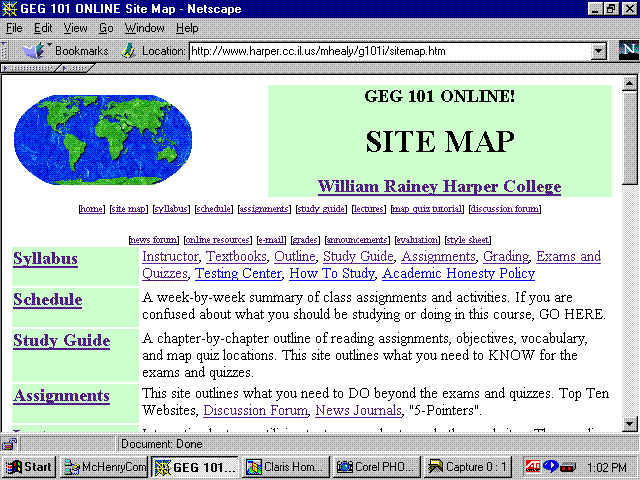
Figure 3 ( http://www.harpercollege.edu/mhealy/g101i/schedule.htm)
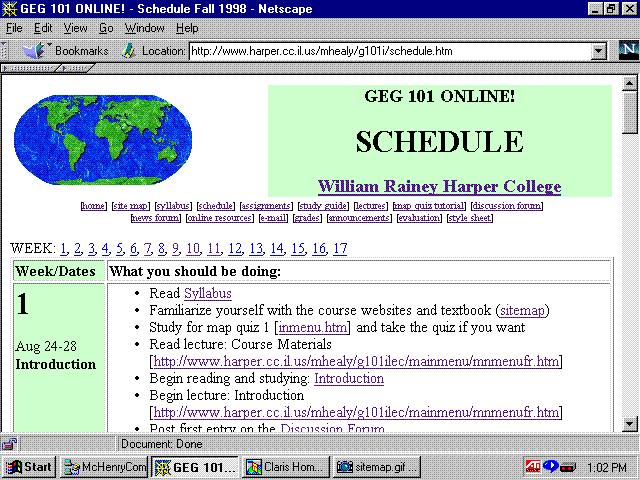
The class schedule is significantly more detailed than those found in traditional classes as it is extensively hyperlinked (figure 3). Distance education students need a substitute for the continual reminders given by instructors in traditional classes. The GEG 101 ONLINE! schedule page provides students with a thorough overview of what is expected week by week including online and textbook readings, quizzes, exams, assignments, and encouragement to begin preparing for upcoming assignments. It is designed to avoid the common problem of students falling behind and eventually withdrawing from the course.
Course Content
Course Content includes the online study guide, lecture modules, and map quiz tutorial. Hypertext is used extensively in the online course content. A common problem with early online courses, and many of the current online world regional geography courses, is that they tend to be dominated by text, with little of the interactivity that the technology can provide.
Yet, it is useful to keep in mind Hill's (1997, p. 38) warning: "Be aware of the dangers of information overload". The internet can provide an excellent vehicle for student-based constructivist pedagogy (Bannan and Milheim 1997), where students learn by following there own interests. Although this helps the students personalize and internalize the learning, there is a great danger of information overload and of a lack of focus. GEG 101 ONLINE! attempts to heed Hill's warnings by allowing for controlled student exploration of a limited number of external web sites and a more extensive use of links to instructor produced internal sites.
The online lectures are the core of GEG 101 ONLINE!. Figure 4 shows the menu page for the lectures on the North America chapter (one of thirteen chapters). The menu allows students to follow their interests and study the short modules in any order they wish. Yet the lecture modules are part of a consistent framework where each chapter is divided into the four "class themes": physical geography, cultural geography, economic geography, and physical geography , as well as a review of the regions of each realm (chapter).
This course structure is further enhanced by the online study guide which organizes the textbook readings, the chapter vocabulary, and the chapter objectives according to the same four themes (figure 5).
Figure 4 (http://www.harpercollege.edu/mhealy/g101ilec/namer/namenu.htm)

Figure 5 (http://www.harpercollege.edu/mhealy/g101i/chapters/nahome.htm)
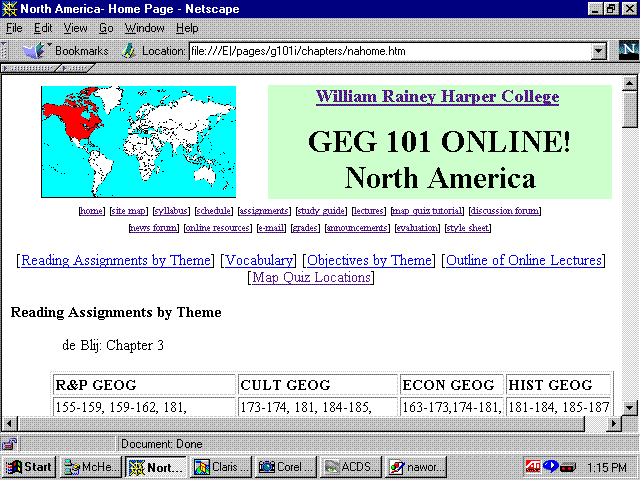
Each module of the online lectures uses a frames environment (figure 6). The screen is divided into four frames. In the upper left corner is the title frame. While studying the module, the student can always see what part of the world they are studying and what topic concerning that area. In the lower left is the text , or content, frame. Students scroll through this frame reading the module. Within the text are hyperlinks that display a map (sometimes a figure or table) in the upper right frame (the map frame). The final frame in the lower left has hypertext links so that students have ready access to all the maps and figures of the module. This allows students a degree of freedom and corresponds to Brown's (1998) "use hypertext for self directed access" feature, as well as Hill's (1997) "develop strategies that empower the learner".
Figure 6 (http://www.harpercollege.edu/mhealy/g101ilec/namer/nac/nacnine/na9found/na9foufr.htm)
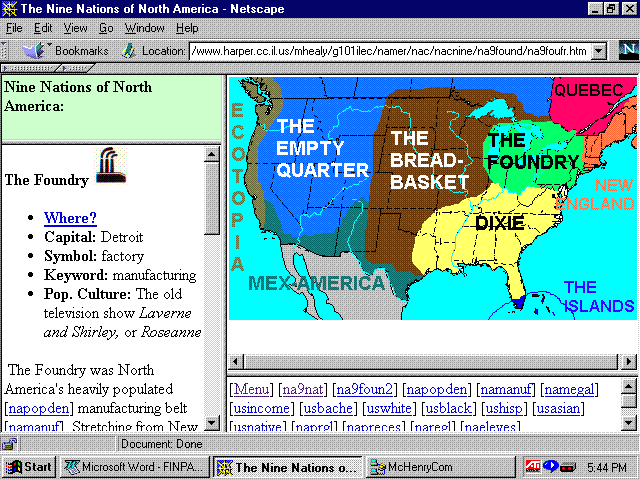
Hill's technological guideline warning: "Be aware of the technology your learners are using to access you WBLE" was followed in the development of these lecture modules. Although a few pages on the world wide web still offer a "no frames" option for web browsers which cannot display frames, the frames format has become a standard feature of web pages and the vast majority of all likely students taking a web-based course have the capability to read them.
Another component of Hill's warning is the technological ability to download pictures (maps) in a reasonable amount of time. In order for the lecture modules to "empower the learner" and encourage higher order thinking, the maps and figures must download and appear on the computer screen very soon after the students click on the hyperlink. The 16-color and 256-color maps used in GEG 101 ONLINE! download onto most student screens in a matter of seconds. Furthermore, the links were located within the text so that the student can continue reading while the map is appearing.
Geography is a very visual discipline and therefore maps are used extensively in the lectures modules. With the corresponding descriptive text, the modules make an attempt to address the different learning styles of the students. In the future, when download times are reduced due to technological advances, the four frames structure of the lecture module could incorporate pictures, audio, and video, addressing additional learning styles. But for now, the desire to keep the modules "web-friendly" and accessible to the greatest number of students prohibits such media.
The final course content component of GEG 101 ONLINE! is the map quiz tutorial (figure 7). A rather lower order thinking skill requirement of many world regional
Figure 7 (http://www.harpercollege.edu/mhealy/mapquiz/namer/naphyfr.htm)
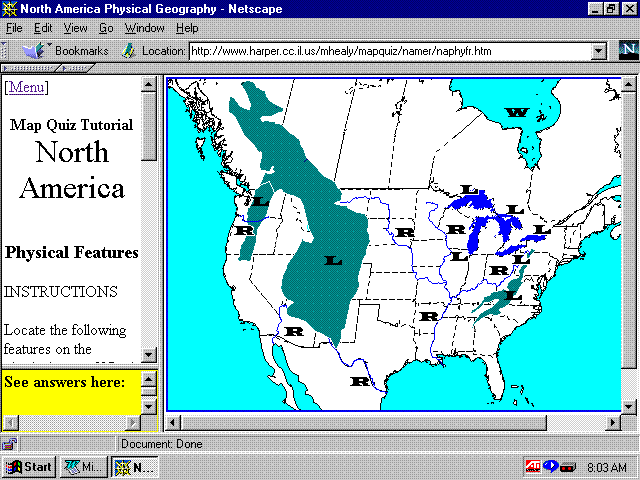
geography courses is place-name geography - memorizing the names of places on the earth's surface. GEG 101 ONLINE! offers an online tutorial that utilizes the multimedia/hypertext capabilities of the world wide web in a web-friendly environment.. All locations, and only the locations, that will be tested in the course are included on the tutorial. Students use menus to access the "countries" tutorial, the "physical features" tutorial, or another tutorial for each chapter studied. Each tutorial includes a "clickable" image map and a list of the required locations. Students can either (1) click on a location on a map and its name appears in the yellow answer box in the lower left frame, or (2) they can find a location on the list of required locations (upper left frame) and try to locate it on the map. Students are tested (for their grade) using both approaches.
Course Activities
Course Activities includes the following online components: discussion forum, news forum, evaluation forum, and an assignment page. A major problem with asynchronous distance education technologies of the past was the difficulty of student-instructor and student-student interaction. Internet technologies, termed computer mediated communication (CMC), have significantly overcome such difficulties. CMC can either be synchronous (chat rooms) or asynchronous (online discussion forums like WebBoard).
The benefits associated with the new asynchronous online interaction technologies have encouraged their use not only in distance education but in traditional education as well.
Brown (1997) reviews the advantages of asynchronous CMC:
GEG 101 ONLINE! utilizes WWWBOARD, a freeware conferencing software package (figure 8) WWWBOARD can be found on the internet at: http://www.worldwidemart.com/scripts/wwwboard.shtml or http://www.wwwboard.com.
Since WWWBOARD does not permit collapsing, or nested, menus, therefore three different forum pages are utilized. The main course discussion forum (http://www.harpercollege.edu/geg101/wbbs/) is used for traditional class discussions. Usually the instructor posts a question or assignment and the students post their responses or findings. Interactivity is encouraged, and at times required, by having students respond to postings of their fellow students.
A news forum (http://www.harpercollege.edu/mhealy/wbbs/news/) is also used. Students are asked to search the web, the newspapers, or the airwaves (TV and Radio) for interesting and appropriate international news stories and write short online reports to be posted on the news forum. Other students are free to read these reports and comment on them via "follow-up" messages. All entries must follow the class style sheet which requires the use of vocabulary and concepts as well as a consideration of the story's location. A list of useful online news sources is provided to the student (discussed below). Finally a course "evaluation forum" (http://www.harpercollege.edu/geg101/wbbs/geg101_wbbs.html) is available for comments and discussion of the methods and structure of the online course itself.
Figure 8 (http://www.harpercollege.edu/geg101/wbbs/)
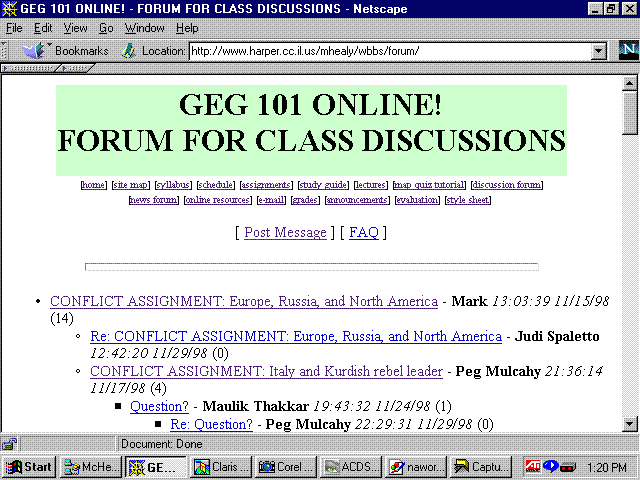
Asynchronous computer mediated communication is an important component of many web based courses. More robust CMC software have the ability to "nest" discussion issues to avoid the long chronological list created by WWWBOARD, e-mail notification, synchronous chat rooms, and the ability to set up separate discussions for different groups of students.
Student assignments for GEG 101 ONLINE! are all web based and include: the discussion forum and the online news journal forum discussed above, as well as the generation of a "top-ten" geography web sites list by each student , and "5-pointer" activities assigned periodically throughout the semester (see: http://www.harpercollege.edu/mhealy/g101i/g1iassig.htm).
Online Reference Materials
Online Reference Materials includes links to geography sites on the internet, news sources, and the student "Top Ten" geography web. These web pages are designed to assist the student in taking advantage of the great amount of information available over the internet.
The Online Resources (http://www.harpercollege.edu/mhealy/geogres/geogres.htm) page (figure 9) has links to web sites in the following categories:
Figure 9 (http://www.harpercollege.edu/mhealy/geogres/geogres.htm)
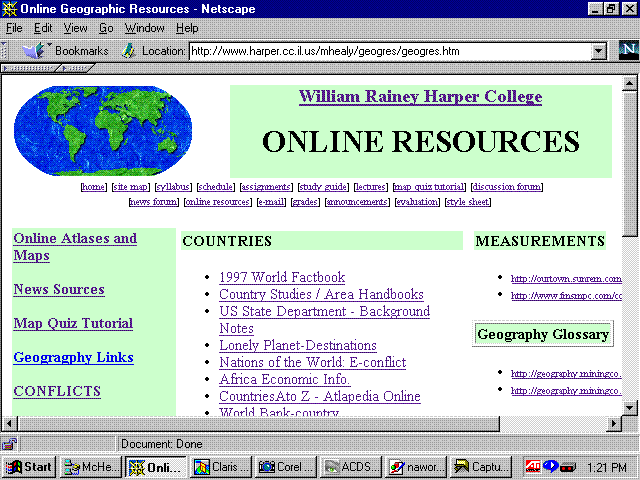
RECOMMENDATIONS
The discussion above was meant to be descriptive. Here, I intend to be prescriptive. Moore and Kearsley (1996, pp. 122-3) list twelve "general design principles" that they contend "apply to all" types of distance education. These twelve principles provide a useful scheme for organizing recommended changes to GEG 101 ONLINE!.
1. Good Structure The organization of the course and materials must be well defined and clear to the student; There must be internal consistency among the different parts of the course. Students should at all times know what they are trying to learn, what is expected of them to achieve the learning, and when they have arrived at the goal. It is easy to become lost as a distant learner, and good design always takes care that this does not happen.
The basic structure of GEG 101 ONLINE! (as described above) appears sound but a bit overdone. Although there is a good degree of internal consistency (use of color, heading designs, a navigation menu on all pages, etc.) the large number of "components" can be confusing. Employing a more robust online forum program could combine the current three forums into one. Restructuring the assignments could also simplify the overall structure.
The need for distance education students to "at all times know what they are trying to learn, what is expected of them to achieve the learning, and when they have arrived at the goal" is discussed in #11 below.
2. Clear Objectives If a course has clear objectives, the task of the instructors in identifying suitable experiences becomes fairly easy; evaluation is easy also. Students and tutors know exactly what is expected of them. The right selection and application of technology is more likely.
GEG 101 ONLINE! clearly lists chapter objectives in the online study guide, but the objectives themselves may not be clear. Also, the objectives do not closely follow the online lectures (i.e. there are some lectures that do not correspond to an objective and a few objectives that do not have a corresponding lecture). Therefore, the whole objective/lecture package needs to be unified, both in content (issues to be studied) and to make the connection between the objectives and the online lectures more clear. One way to do this may be to list the appropriate objective at the beginning of each online lecture module.
3. Small Units The content of the course and the way the materials are organized and presented should be broken down and presented in small units. these may correspond to a single instructional objective or learning activity.
No revision recommended.
4. Planned Participation Opportunities for interaction, through student activities and exercises, are embedded throughout the course and materials.
GEG 101 ONLINE! has several opportunities for interaction. Student-content interaction is apparent in the frames structure of the online lectures. I do recommend that improvements be made in the student-student and the student-instructor interaction activities.
The primary mechanism for student-student interaction is the online discussion forum. More thought and planning have to go into the discussion questions, their numbers should be increased, and they need to be designed to better encourage interaction.
The internet does have additional tools that could foster student-student interaction such as chat rooms, and e-mail. These tools can overcome the problems of conducting group activities of other distance education technologies. I recommend that the efficacy of such activities be investigatedr.
Student-instructor interaction has been primarily via e-mail and the discussion forum. Use of both means ought to be enhanced. An advantage of web-based courses is this interactivity. It should therefore be emphasized. I recommend one e-mail to all students per chapter (thirteen per semester). These will remind the student of the class schedule, important issues, up-coming important dates, and can be used to integrate relevant current events into the course.
5. Completeness The course materials or program must contain extensive commentary or examples like those that would be provided, often extemporaneously, in a traditional classroom setting.
This is a very important principle. The online world geography course at Texas A&M University - Kingsville (McAdams 1998) includes many examples of the instructor's personal visits to the regions being studied with "extemporaneous" encouragement given to students to travel and see the world themselves. This certainly gives the distance education student the feeling of being in a classroom with the instructor. Yet, just like in the classroom setting, the instructor needs to assure the relevancy of such "extemporaneous" comments, especially with the generally more motivated and dedicated distance education student.
Ideally, the online lectures should be reviewed and modified, chapter-by-chapter, each semester prior to their use by the students. Relevant current event issues and references to the online class discussions should be added, just like they would be in the traditional classroom. The relative ease of such revisions is another advantage of web-based instruction over other asynchronous distance education formats. Yet they could become quite time consuming. Such revisions could possobly be written in a way that would not make the lectures "semester specific" and still convey to the current class the intended connections.
6. Repetition Important ideas should be repeated periodically (especially in summaries) to provide reinforcement and to compensate for distractions and memory limitations.
There is a significant amount of repetition of the important concepts in the online lectures. Furthermore, the style sheet used for the written assignments requires that students list realm (chapter), region, class theme, and class vocabulary applicable to the student's work. The lack of summaries is a problem with GEG 101 ONLINE! that will be addressed below in #11.
7. Synthesis Important ideas expressed in the materials or contributed by students should be woven together (especially in summaries).
Little of this is currently being done in GEG 101 ONLINE! I recommend that the chapter e-mail messages recommended above incorporate summaries of the previous chapters and previews of the up-coming material with important connections and differences clearly identified.
8. Stimulation Through the use of interesting formats, content, or guests, course materials need to capture and hold the attention of students.
It is hoped that the frames format of the online lectures provides some degree of stimulation. Furthermore, I recommend that the instructor increase his attempts to get online discussion forum guest "speakers". A goal of three per semester seems appropriate. Inclusion of online guests is another underutilized capability of web-based instruction in GEG 101 ONLINE!
9. Variety Information should be presented in a number of different formats and different media to appeal to varying interests and backgrounds of the students.
It is recommended that the instructor keep the materials "web-friendly" and not employ the newer, often slower, multimedia capabilities of the internet as not all students may have the technological capability to access them.
But, other distance education technologies should be examined for possible incorporation into the course. The U.S. mail could be used more to distribute print-based materials. The online study guide could also be sold in the college bookstore in print format. Each student could be telephoned once or twice each semester. And various radio, television, or video programs could be incorporated provided that possible student time constraints be accommodated.
The subject matter of world geography lends itself well to a wide variety of media. It is recommended that the instructor investigate ways to incorporate these media into GEG 101 ONLINE!.
10. Open-ended Assignments, examples, and problems should be open-ended so they allow the students to adapt the content to their own interests or situation.
"Open-ended" assignments encourage student led discovery but may not pertain to the subject matter being studied. The internet has the advantage of encouraging such open-endedness via the online discussions and the wide range of materials available on the web. Yet, the technology also allows for student-instructor interaction so that the instructor can keep the discovery processed focused. The amount and efficacy of open-endedness should be continually reviewed.
11. Feedback Students should receive regular feedback on their assignments or progress in the course.
The ability of increased feedback is a further advantage of web-based instruction over more traditional distance education technologies which should be utilized.
It is recommended that the instructor set aside specific times each week to devote to course work. This helps assure more timely feedback to the students.
Also, review and summary exercises need to be incorporated into the online lectures, or via the online study guide, to provide feedback to the student who has completed the lecture so s/he can assess their level of competence. Review questions with answers, self-grading online multiple choice questions, or written summaries could be incorporated throughout the course.
12. Continuous Evaluation The effectiveness of the materials, media, and instructional methods should be routinely assessed using a variety of methods.
An attempt for student evaluation of the course materials was made through thew evaluation forum discussed above. More, and more specific, evaluation procedures need to be developed.
Little, or nothing, was said in this paper about other important issues of web based courses including: the course development process including the extensive time commitment, the technical requirements and support, faculty training in distance education theory and pedagogy, the administrative structure and support required, the lack of student services offered at a distance, copyright issues, and numerous other vitally important issues concerning online courses. As stated in the introduction, the purpose of this paper was to, describe and recommend changes to, GEG 101 ONLINE!. Through this writing process I was also able to review some of the literature on the design and functioning of web based courses. The next appropriate step would be to act on the recommendations made in this paper and make modifications to GEG 101 ONLINE!.
Bannan, Brenda, and Milheim, William D. (1997) Existing Web-Based Instruction Courses and Their Design. In Khan, Badrul H. (ed) (1997), Web-Based Instruction. Englewood Cliffs, New Jersey: Educational Technology Publications, Inc.
Black, B. and Stanley, N. (eds) (1998). Teaching and Learning in Changing Times. Proceedings of the 7th Annual Teaching Learning Forum, The University of Western Australia, February 1998. Perth: UWA. http://cleo.murdoch.edu.au/asu/pubs/tlf/tlf98/
Brown, Allison (1998). Wise design for WWW courses. In Black, B. and Stanley, N. (eds) (1998). Teaching and Learning in Changing Times. Proceedings of the 7th Annual Teaching Learning Forum, The University of Western Australia, February 1998. Perth: UWA. http://cleo.murdoch.edu.au/asu/pubs/tlf/tlf98/
Brown, Allison (1997). Designing for learning: what are the essential features of an effective online course? Australian Journal of Educational Technology, 13(2), 115-126. http://cleo.murdoch.edu.au/ajet/ajet13/su97p115.html
Khan, Badrul H. (ed) (1997). Web-Based Instruction. Englewood Cliffs, New Jersey: Educational Technology Publications, Inc.
Hill, Janette R. (1997). Web-based Learning Environments: Guidelines for Development and Implementation. Journal of Public Service and Outreach, 2(3), 36-43.
McAdams, Michael A. World Geography Internet Course (GEOG 1303-650) http://www.tamuk.edu/webuser/geo/Geog/ . Texas A&M University - Kingsville Accessed December 1998.
McCollum, Kelly (1998). Virtual Universities Report Robust Enrollments for Distance-Education Courses. Chronicle of Higher Education. [online], Available: http://www.chronicle.com/free/98/11/98111901t.htm
Moore, Michael G., and Kearsley, Greg (1996). Distance Education: A Systems View. Belmont, Califorinia: Wadsworth Publishing Company.
Pitt, Tina Joy and Clark, Anne (1997). Creating powerful online courses using multiple instructional strategies. [online], Available: http://leahi.kcc.hawaii.edu/org/tcc_conf97/pres/pitt.html
GEG 101 World Regional Geography - "GEG 101 ONLINE!"
Instructor: Mark Healy
School: William Rainey Harper College
URL: http://www.harpercollege.edu/mhealy/g101i/home.htm
GEO 111 World Regional Geography
Instructor: Dave Flanagan
School: Central Piedmont Community College
URL: http://152.43.41.9/Geo111/Online/geowb99.htm
Geography and Recreation 1030
Instructor: Dr. Jerry Nelson
School: Casper College
URL: http://wind.cc.whecn.edu/~gnelson/wrgeog/introwrg.html
GEG 1000 World Regional Geography
Instructor: Sharon Gabel
School: Metropolitan State College of Denver
URL: http://clem.mscd.edu/~gabels/geg1000/geog-fall98-syllabus.htm
GEOG 1303 World Geography
Instructor: Dr. Michael A. McAdams
School: Texas A&M University - Kingsville
URL: http://www.tamuk.edu/webuser/geo/Geog/
GY 102 World Regional Geography
Instructor: Dr. Tom L. Martinson
School: Auburn University
URL: http://www.auburn.edu/academic/liberal_arts/geography/martinson/gy102/index.html
GEOG 160 World Regional Geography
Instructor: Dr. Elizabeth Dudley-Murphy
School: University of Utah
URL: http://www.dce.utah.edu/ulearn/courses/geog/geog160.html
GEOG 1303 World Geography
Instructor: Scott Girhard.
School: San Antonio College of the Alamo Community College
District
URL: http://WWW.accd.edu/sac/EARTHSCI/1303.090/HOME.htm